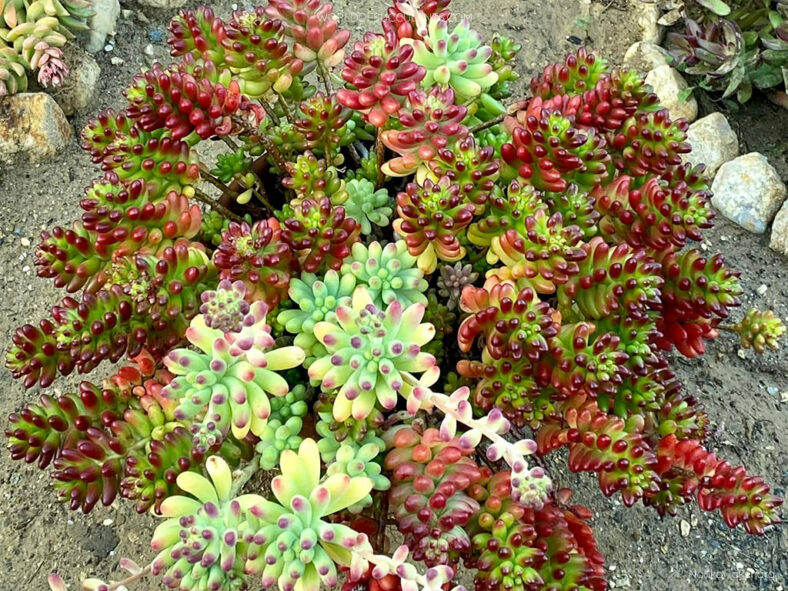Sedum is a large genus of succulents in the family Crassulaceae, primarily native to rocky, mountainous environments in the Northern Hemisphere but also in the Southern Hemisphere in Africa and South America. It was described by Carl Linnaeus in 1753 as a genus with about 600 species, subsequently reduced to around 450 species by forming up to 32 segregate genera. The members of this genus are commonly known as Stonecrops because many gardeners joke that only stones need less care and live longer.
Sedums are a quite diverse group of plants that include annual, biennial, and perennial ground covers, subshrubs, and shrubs. They have thick stems and attractive, fleshy, colorful leaves that vary in size from small and needle-like to large, flattened, or cylindrical. The foliage colors change through the seasons, ranging from green to blue, yellow, orange, red, and purple. Star-shaped, generally five-petaled flowers usually appear in clusters and come in shades of pink, red, yellow, or white. They are highly attractive to bees and butterflies. Most Sedums bloom in the summer and fall.
The generic name "Sedum" derives from the Latin "sedeo," meaning "to sit," and refers to the growing habit (they sit and sprawl over the rocks and walls) of many of the Sedums.

Growing Conditions for Sedum
Because Sedums tolerate a wide range of harsh conditions, they make a good choice for many gardens. They are also excellent container plants.
Light
These succulents thrive best in locations that receive full sun for at least six hours daily. Most species will tolerate partial shade but will not thrive in deep shade. Keep indoor Sedums in a sunny window or under artificial lights.
Soil
Sedums do not thrive in waterlogged soil, so proper drainage is essential to prevent root rot. Choose a well-draining soil mix.
Their ability to thrive even in shallow, poor, sandy, or rocky soils has made them popular for green roofs.
Temperature
Sedums can tolerate freezing temperatures. Most are cold-hardy in USDA hardiness zones 5a to 9b, with a temperature range of -20°F to 30°F (-28.9°C to -1.1°C). Some species, such as Sedum sexangulare, can tolerate temperatures as low as USDA hardiness zone 4a, or -30°F (-34.4°C). Sedums are also tolerant of heat and drought.
Keep indoor Sedums at temperatures between 60°F and 70°F (15°C and 21°C) throughout the winter. Plants start to go dormant when temperatures drop below 50°F (10°C).
General Care for Sedum
Once established, Sedums require little care, making them an excellent choice for beginners.
Watering
Sedums are drought-tolerant but do need some water. They do their best with regular watering from spring through fall. Water thoroughly and wait for the soil to dry out before watering again. Young Sedums will need supplemental water for the first few weeks to establish roots. In many regions, established plants need only rainfall. Avoid wetting the leaves, stems, and flowers when watering. In winter, water them just enough to keep your plants from shriveling.
Container-grown plants often require more water than their counterparts growing in open soil.
Fertilizing
A balanced organic fertilizer each spring is generally all Sedums require. Feeding is unnecessary as long as the plants are divided annually and provided with fresh soil.
Repotting
Sedums in containers do require a little more care than those in gardens. Repot your plants when they outgrow their current pot by moving them to a larger container to provide better support. Spring is the best time to repot Sedums. Ensure the soil is dry before beginning the repotting process.
Pruning
Pruning is unnecessary unless Sedum plants get wild and out of control. After winter, you can clean them up by removing any dead or damaged leaves or branches.
How to Propagate Sedum
Once you have one Sedum, it is easy to make more by taking stems or leaf cuttings and dividing the plant. Sedums are also easy to grow from seed.
Stem Cuttings
Propagation from stem cuttings is the easiest way to propagate Sedums. Take cuttings in spring when the plants are in active growth. Select a healthy stem and remove it from the main plant. Allow the cutting to callus for several days before placing it in a well-draining soil mix. Water sparingly until the cuttings produce roots.
Leaves
Each leaf on your Sedum could potentially become a new plant. Choose healthy leaves, remove them from the plant, and allow them to callus for several days. Place the leaves on a well-draining soil mix and keep the soil slightly moist. They should be well rooted after 2 to 3 weeks, with new plantlets forming at the base.
Division
Once Sedums have finished flowering, it is the right time to divide the plants. The division is a simple method of doubling your investment. Most Sedums benefit from division every two to three years to control the size and keep the plant healthy.
Seeds
Propagating Sedums with seeds is the slowest method, but seeing new plants develop from tiny seeds is also exciting. Spring or summer is the best time to sow the seeds. Use a well-draining soil mix. Sow the seeds on the soil surface and gently press them into the soil. Keep the soil moist until the seeds germinate. Provide a consistent temperature between 65 and 70 °F (15 and 21 °C). The seeds usually start to germinate after 2 to 4 weeks.
Pests and Diseases of Sedum
Sedums rarely show signs of pests and diseases, but are not entirely immune.
Pests
If overwatered or overcrowded, Sedums may be infested by scale insects and mealybugs. Snails and slugs may also be problematic outdoors. Fortunately, they are relatively easy to control and prevent.
Diseases
Sedums are susceptible to diseases such as rot, rust, and mold in wet environments.
Toxicity of Sedum
Sedums are not listed as toxic for people, but can be mildly toxic to pets and children.
Links
- Back to genus Sedum
- Succupedia: Browse succulents by Scientific Name, Common Name, Genus, Family, USDA Hardiness Zone, Origin, or cacti by Genus